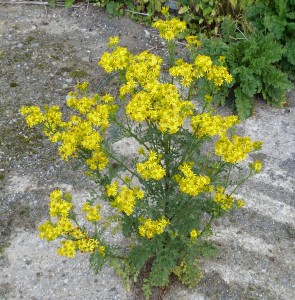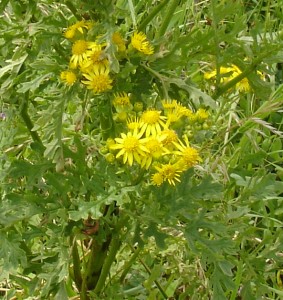Ragworth
Latin: Senecio jacobaea
Irish: Buachalán buī
This native perennial is from the same family as the daisy (Compositae) is an abundant and colourful resident of roadsides, pastures and waste places. It grows to a height of 30-150cm. Its leaves are cut into mostly blunt, toothed lobes and have no, or a very short, stalk. Dense, flat-topped clusters of deep yellow flowers are produced during June to September.
Since Ragworth is a “noxious weed” there are legal consequences for landowners on whose land it grows but there are even more serious consequences for livestock on such land. The leaves contain alkaloids in sufficiently high quantities to cause cirrhosis of the liver. Cattle and horses are particularly sensitive and although stock will generally avoid grazing Ragworth but will readily consume fatal amounts of it in hay or silage. One of the few organisms that can ingest Ragworth poisons without harm are the black and amber caterpillars of the Cinnabar Moth who use the toxins to protect them from predatory birds.
Despite its poisons Ragworth has been used in Irish folk medicine. In many counties, the leaves are the basis of poultices and other treatments for cuts, sores, boils, burns and scalds. It was also regarded as a cure for jaundice, perhaps because of its yellow flowers.
Growing on the headlands of the practice area, in the Builder’s Paddock and the machinery yard, and along the roadsides at the entrance to the club.

